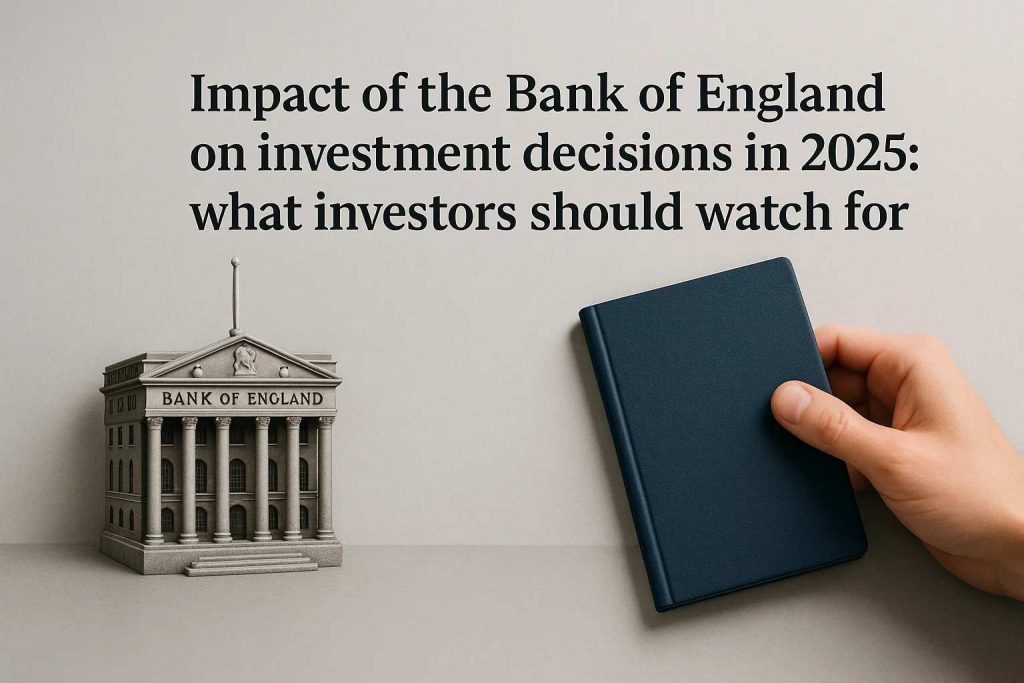The global financial landscape in 2025 is being shaped by a series of decisions made by central banks, and the Bank of England stands out as one of the most influential. For global markets and especially European investors, the policies set in London ripple across the broader spectrum of economics, trade, and corporate strategies.
The challenge for investors is not only to follow the bank’s decisions but also to interpret the underlying motives behind them. Monetary policies, interest rate adjustments, and communication strategies all affect the valuation of assets. Understanding the impact of these choices means identifying how they interact with inflation, consumer spending, corporate borrowing, and currency stability.
Monetary policy and its effect on markets

The Bank of England’s monetary policy in 2025 continues to revolve around controlling inflation and ensuring financial stability. After years of fluctuating prices and energy shocks, the institution has adopted a measured stance, balancing between encouraging economic growth and preventing runaway inflation. When interest rates are high, borrowing becomes more expensive, curbing business expansion and consumer credit. Conversely, lower rates stimulate investment but may also risk overheating the economy.
For investors, the implications are substantial. The bond market reacts immediately to rate changes, while equities tend to adjust more gradually, reflecting future profitability prospects. Currency traders also pay close attention, as pound sterling valuations often swing in response to shifts in interest rate expectations.
Inflation and consumer confidence
Another critical element of 2025 is the Bank of England’s approach to inflation management. In recent years, inflationary pressures have stemmed not only from traditional drivers like energy prices but also from supply chain reorganizations and labor market tensions.
This gap between technical stability and perceived reality impacts investment decisions. Companies dependent on consumer spending face the challenge of forecasting demand in an environment of mixed signals. Retailers, real estate developers, and even technology providers that rely on discretionary income must interpret not just raw inflation data but also how the public feels about their purchasing power.
The role of communication and transparency
Central banks influence markets not only through actions but also through words. The Bank of England’s statements, press conferences, and reports are meticulously analyzed by traders, economists, and portfolio managers. The clarity—or lack thereof—of communication can set off significant waves in both domestic and international markets.
A single phrase in a speech can alter market expectations, sending asset prices soaring or plunging. For long-term investors, this environment requires discipline and the ability to separate noise from genuine signals. Understanding the institutional language of the Bank of England provides a competitive edge, allowing more accurate predictions of future moves.
Technology, regulation, and new financial instruments
While traditional levers like interest rates remain at the core of the Bank of England’s influence, technology and innovation are expanding the scope of its impact. The rise of digital assets, fintech platforms, and alternative financing models introduces both opportunities and risks.
The bank’s approach to regulation in 2025 is therefore not only about safeguarding consumers but also about ensuring systemic resilience. Decisions on digital pound initiatives, oversight of fintech ecosystems, and cross-border regulatory cooperation can significantly alter investment landscapes.
Geopolitical challenges and investor positioning
Finally, the Bank of England’s decisions cannot be analyzed in isolation from the broader geopolitical environment. Trade relations, energy security, and political alliances influence the context in which monetary policy operates. In 2025, Europe continues to face pressures from shifting global supply chains and evolving trade blocs, while the United Kingdom positions itself as a flexible yet stable financial hub.
For investors, this means that reading the Bank of England’s stance requires awareness of how global forces intersect with domestic policy. A rate adjustment or a regulatory reform might have different consequences depending on whether it occurs in a moment of international tension or stability.





